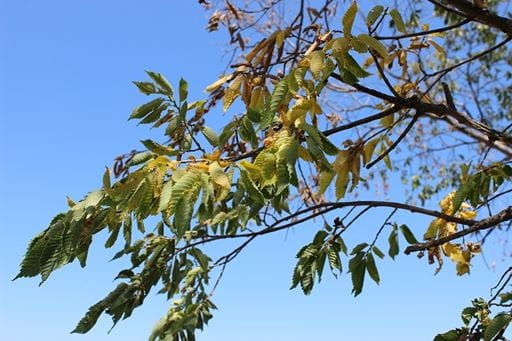Released on March 15, 2024
The annual ban on pruning elm trees in Saskatchewan begins April 1 and runs until August 31. The ban is in place to protect the province's elm trees by helping slow the spread of Dutch elm disease (DED).
DED is caused by a fungus spread by elm bark beetles. These beetles are attracted to fresh cuts on elm trees. With warmer weather, these tiny beetles become more active, increasing the risk of infection. Adhering to the pruning ban reduces tree wounds during heightened beetle activity, helping reduce the spread.

In addition to respecting the pruning ban, there are other things you can do to protect your community's elm trees:
- Pruning your trees before or after the ban period keeps them healthy and better able to resist all kinds of diseases, including DED. Elm bark beetles are attracted to and breed in dead and dying elm wood, so eliminating their habitat with proper pruning reduces beetle numbers.
- Improper pruning can damage trees and spread diseases. If you hire someone to prune your trees, check their qualifications. Anyone who prunes elms commercially must have completed a recognized training program or be supervised by someone who has.
- Transporting wood can spread DED and other insects and diseases. That's why it's illegal to use, transport, store or sell elm firewood. Provincial regulations restrict the use, transport, storage and sale of elm logs.
- If you see an elm showing signs of DED - wilting, yellowing leaves on one or several branches near the top of the tree, usually beginning in late June - take a sample and submit it to the Provincial Crop Protection Laboratory for testing or report it to your local municipality at Crop Protection Laboratory | Crops Programs | Government of Saskatchewan.
Elm trees are often seen arching over the streets and have a distinctive umbrella-like canopy. They have dark green leaves that are oval or egg-shaped with a pointed tip. Elm bark is deeply grooved in older trees and silver grey in color. It can often be easily broken off to observe alternating red and cream 'wafers' in cross-section.
You are allowed to completely remove an elm tree at any time of year, including during the ban period, but it's critical to dispose of all elm wood promptly and properly. Contact your local municipality to find out where the designated disposal site is in your area.
For more information, contact your local municipality, the Ministry of Environment Inquiry Centre at 1-800-567-4224 or visit saskatchewan.ca/forestry.
-30-
For more information, contact:
Val Nicholson
Environment
Prince Albert
Phone: 306-953-2459?
Email: val.nicholson@gov.sk.ca

